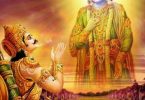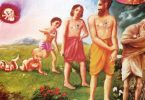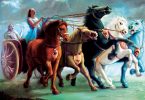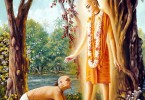Question: Why Krsna and Balarama didn’t attend gurukula in Vrindavan/Nandagram?
According to VCT, Krsna spent 3 years and 4 months in Gokula, 3 years and 4 months in Vrindavan, after which time Nanda Maharaja shifted residence to Nandagram. At the age of 10 years and 7 months, on the eleventh lunar day of the dark fortnight of the month of Caitra, Krsna went to Mathura, and on the fourteenth day thereafter He killed Kamsa. Thus Krsna completed His kaisora period at age ten, and He eternally remains at that age.
SB and acaryas provide the following information:
After killing Kamsa, They took diksa from Gargacarya (SB 10.45.29) and joined the gurukula of Sandipani Muni in Avanti (SB 10.45.31).
SB 10.47.21 (api bata madhu-puryam…) Compared to the translation in Cc Adi 6.68, Radharani’s “Talks with the Bumblebee” is translated differently in Cc Antya 19.107 as:
“Krsna is now living like a gentleman at the gurukula in Mathura…”
The mention of gurukula comes from Sridhara Svami: “O gentle one, after returning from the gurukula, is the son of the respectable (Nanda Maharaja), Krsna, now living in Madhupuri?”
Jiva G.: “First she asks this question, since there has been no news of him for a long time and as well she had heard that he had gone far away to the gurukula.”
To some, it seems a bit surprising that there was no mention of gurukula either in Vrindavan or in Nandagram. Is there specific commentary by our acaryas to explain this situation?
Answer by Romapada Swami:
The quotes below provide the answer, plus the following is to be considered.
To attend gurukula, a child has to be away from the family. Not only that, everyone in Vrindavan just loved Krsna so much. How would they have trained Him? How would they have disciplined Him? Krsna was far too clever! And with all his friends nearby etc., it would have been impossible. Imagine: how could Krsna be in a nearby gurukula with hundreds of loving gopis surrounding him and staring at him!
In the sections of Jiva Gosvami’s Gopal Campu copied below, he explains why Krsna chose Sandipani Muni to learn from. He explains that Sandipani Muni wasn’t a vaisnava. If he went to Vyasadeva, or any other great vaisnava living at that time, then they would have immediately recognized who He was and they too would have been unable to train Him. Sandipani Muni was a greatly learned teacher and a worshipper of Lord Siva. One can see even to this day in Sandipani Muni’s ashram in Avantipur, Ujjain that he never wears vaisnava tilak. Lord Siva, being the greatest of Vaisnavas, somehow brought Krsna there. Gopal Campu says that Krsna and Balarama totally won over the heart of Sandipani Muni. Krsna reconciled or removed his misconceptions.
Ultimately, it was Krsna’s mercy on Sandipani Muni; He wanted to give him mercy. Consider the fact that Purnamasi – the mother of Sandipani Muni – was Yogamaya personified for Vraja, and Madhumangala – the son of Sandipani Muni – was Krsna’s intimate friend in Vraja. There must have been a very deep relationship between Sandipani Muni and Krsna! Krsna’s preference to accept him as His teacher is perfectly natural.
There is a self-manifest saligrama sila in his ashram, which came as a reciprocation with Sandipani Muni’s worship there.
The cowherd boys also received gayatri in Vraja; and while it doesn’t talk of their going to study at a particular school, one could argue that they would want to do whatever Krsna did and that they too would have studied in Vraja. After all, there were learned brahmanas in Vraja, such as Bhaguri Muni (the learned chief priest of Vraja, a sabhä-paëòita who recited Vedic literatures in the house of Nanda Mahäräja) and others, whose duty was teaching.
***
Gopal Campu – Purva Campu – Part 3, Chapter 33
[65] Närada said, “Vasudeva and others will have Garga give you the sacred thread. On that occasion Rohiëé will come from Vraja, but not the people of Vraja, for it will be difficult for them to uproot the grief caused by seeing you become a kñatriya.”
[66-67] Kåñëa thought to himself, “Ah! Their grief about my being a kñatriya and not going is not proper since they are attached to me in their hearts. Rohiëé is the friend of my mother. How can they be separated? I will ask about another topic.” Then he spoke aloud, “Then what will I do?”
[68] Närada said:
You two brothers will go the bank of the Avanté River to the enlightened school of Sändépani and with no dejection enter the gurukula as brahmacärés with great reverence to learn pure knowledge. You will astonish everyone by studying and understanding each subject in one lesson. The teachers will see this in astonishment, praising you in exasperation.
The husband of Lakñmé has limbs softer than a new sprout. Service to him brings into blossom all desired objects of unlimited servers. His great learning makes Sarasvaté greedy for his knowledge. He collects wood on the instructions of his guru’s wife with great pleasure.
Gopal Campu – Uttara Campu – Part 1, Chapter 8
[11] When Vasudeva was determined to have the sacred thread ceremony, Rohiëé did not propose bringing the people of Vraja.
[12] Though Kåñëa and Balaräma were eager for this ceremony – understanding that the Yadus were rather indifferent to the people Vraja in their minds and actions, and considering it would be painful for the Vraja people – they decided not to invite them, though all citizens were invited. What is the use of our wanting to describe this event to them? But through Sudäma, the garland maker, they had Nanda hear a sweet letter:
O father! Tomorrow in the morning the Yadus will accept us as their sons by the sacred thread ceremony, showing us to be kñatriyas. I will accept this external show as a kñatriya but internally I am still a cowherd. Ah! Previously I said that I would come to see you, my relatives. How can I, your son, do the opposite with my tongue?
O Nanda! Do not lament that you will not be present at the sacred thread ceremony. In Mathurä I hide my real nature for the benefit of your friends the Yadus. Perform the gäyatré initiation ceremony for my Vraja friends who are my very form and make my vow complete.
[13] Hearing this letter, Nanda, Upananda and others began to think. “From this letter, combined with the previous advice, it seems that he is not indifferent to us. We have already thought that we should perform this ceremony, which is recommended for us vaiçyas. Therefore, we will perform the ceremony using his friends who are his representatives — who are one with him internally but identify themselves otherwise externally.”
[14] Snigdhakaëöha said, “Please describe the actions.”
[15] Madhukaëöha said:
When the ceremony for second birth was completed in both places, the two boys wanted to learn the four Vedas and their aìgas. They decided that they should follow the same process as others do. “According to the ancient sages one should study by going to the gurukula. Though Vyäsa and others of great stature would be suitable as gurus and are well known, they will think that we two already have all knowledge. Therefore they will show some hesitation to be our guru. They are the highest Vaiñëavas and have realized the Vaiñëava philosophy. We should study and that will be attractive. Though we have knowledge by our natures, it is best that we go to the gurukula. If we break the rules it will not be auspicious for the world. A person who is fixed in Brahman and worships Çiva would be the best guru. The great soul Sändépani of a dynasty from Käçé is a worshiper of Çiva. He previously went to Prabhäsa and now lives in Avanti, a place emanating happiness and near to a Çiva temple. We should go there, but in such a way that others do not know. Otherwise, if it is widely known that we have gone far away, the enemies will give problems to the Yadus. And people of Vraja from our father’s family down to the paid servants will give up their bodies. What to speak of your mother Yaçodä who displays the most intense pain to all people.”
[16-17] After considering in this way, the two made a plan to inform the Yadus and fool all others. They decided to fool everyone by making a show of performing vows alone in their houses. Thus, going far away, secretly, will prevent others from coming.
[End of Gopal Campu quote]
Manu Samhita 2.36 – the timing of upanayana as prescribed for ksatriyas
“In the eighth year after conception, one should perform the initiation (upanayana) of a Brahmana, in the eleventh after conception (that) of a Ksatriya, but in the twelfth that of a Vaisya.”
“Thereafter, His father, being afraid of Kamsa, brought Him to the cow pastures of Maharaja Nanda, and there He lived for eleven years like a covered flame with His elder brother, Baladeva.”
VCT’s commentary for SB 10.45.3
“At the age of 10 years and 7 months, on the eleventh lunar day of the dark fortnight of the month of Caitra, Krsna went to Mathura, and on the fourteenth day thereafter He killed Kamsa. Thus Krsna completed His kaisora period at age ten, and He eternally remains at that age.”







